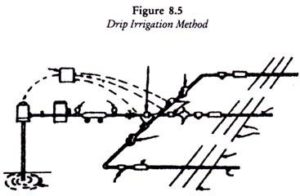The following are the main organs of drip irrigation method: water pump, main PVC, pipeline, branch PVC pipeline connected to main line, plastic pipes connected to branch line, drippers connected with plastic pipes, fertilizer tank for application of fertilizers, valve, water measure, pressure controller, filter etc. Internal radius of side pipe is from 10 to 32 mm. Side pipelines are fitted with drippers from where water falls in drops. Efficiency of drip irrigation method depends on suitable operation of drippers. Flow rate of drippers is 2 to 10 litres per hour.

This system of irrigation is established on the basis of type of crop, distance between plants, requirement of water for crops and distance of water source from the field.
Advantages:
1. In this method, water directly reaches the roots of the plants, which take water to plants in balanced quantities.
2. Drip irrigation method saves 30 to 70 per cent water and it is possible to irrigate three times more area with the same amount of water.
3. In this method, weeds do not spread because water reaches only near plants and does not spread in the whole field.
4. Fertilizers and insecticides can also reach the plant directly by solution in the water and it saves 30 to 60 per cent chemical fertilizers as well as 40 to 50 per cent pesticides along with saving of water.
5. Even in case of uneven lands, drip irrigation method can do balanced irrigation.
6. Cultivation in saline and alkaline soil also can be done by this method of irrigation.
7. Crop production is higher by 20 to 40 per cent in drip irrigation method, because plants can get air and water in required quantities, resulting in regular growth of crops.
8. Lesser labourers are required for irrigation work.
9. Bacteria causing diseases in crops do not grow because of dry atmosphere near plants.
Disadvantages:
1. Drip irrigation method is expensive.
2. It requires special technical knowledge for successful operation of this method.
3. In heavy soils, it creates problems of flow and water blockages.
4. Plants are able to get nutritive elements in a very limited area.
5. It is not suitable for every crop.
6. Utmost care has to be taken for holes of drippers, because soil may come along with water at any time, which will prevent water dripping smoothing from holes.
7. Animals may cause damage to branch pipelines and dripper pipelines.
8. Most of the drippers work on pressure. Wherever land is sloppy, pressure on valves increases by 50 to 10 per cent, which results in stoppage of working of valves on the upper side.
